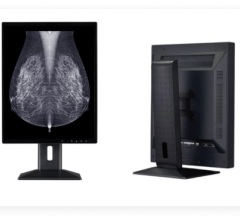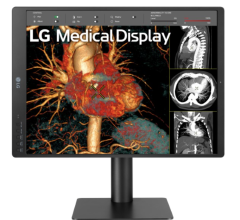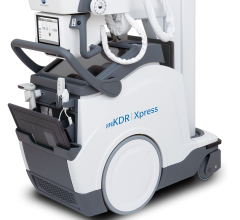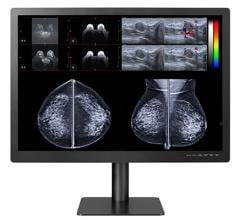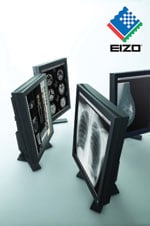
All Eizo medical-grade monitors are adjusted for uniform brightness and DICOM calibration.
Until recently, medical-grade flat panel displays have been the obvious choice for reading diagnostic imaging exams. But advances in commercial off-the-shelf (COTS) display technology coupled with a lower list price have prompted many radiology groups to make the controversial decision to choose commercial-grade over medical-grade displays.
For the most recent news, visit the ITN channel on medical-grade flat panel display monitors.
While medical-grade displays are still recognized for providing higher quality screens compared to their consumer-grade counterparts, a new study suggests the gap between the two might be narrowing.
Elizabeth A. Krupinski, Ph.D., professor and vice chair of research, department of radiology, University of Arizona, published a study comparing the diagnostic accuracy of radiologists viewing the clinical images on a top-of-the-line medical-grade versus a top-of-the-line COTS color display.
In the study, “Medical Grade vs. Off-the-Shelf Color Displays: Influence on Observer Performance and Visual Search,” published in the August 2009 issue of the Journal of Digital Imaging, researchers compared the panels in a head-to-head clinical trial. They adjusted luminance values of the two panels to simulate a display that had been in use for one year.
The results showed, “Total viewing time did not differ significantly, but eye position data revealed differences, suggesting better search and decision-making efficiency with the medical-grade display. Medical-grade color displays at one year...yield better diagnostic and search efficiency than COTS color displays, and thus are recommended for primary reading, if color displays are to be used.”
While the study revealed some statistical differences, Krupinski told Imaging Technology News in a phone interview, the diagnostic performance was actually relatively close.
“Statistical difference doesn’t always translate into a practical [difference]. From a clinical perspective, I would say it was probably negligible,” she said. “Yes, the medical grade panels are still better than the off-the-shelf, but that difference is getting so small, within the next [few] years, I venture to say there will be no difference.”
Still, Krupinski recommends that medical-grade technology, which produces “crisper, clearer, sharper” images with less noise and has a longer life span than commercial displays, should remain the standard in certain applications, such as mammography, chest and bone imaging. Due to higher spatial resolution contrast differences, lack of reliance on color, and other inherent complexities, it’s very difficult for radiologists to accurately identify subtle and small lesions without medical-grade technology, she said. When it comes to less complex classes of imaging, such as ultrasound (US), magnetic resonance imaging (MRI) and computed tomography (CT), she sees no reservations in hospitals opting for the more affordable consumer-grade displays.
Proceed With Caution
However, a recent report released by NEC Display Solutions of America cautions radiologists against using consumer-grade liquid crystal displays (LCDs) for primary diagnostic reads. The rise in popularity of COTS, caused in part by the increase in teleradiology, as well as monetary perks, can “adversely affect both patient safety and radiologist productivity,” according to NEC. “Although the consumer display technology has improved drastically in quality over the years, the trade-offs are substantial and warrant scrutiny.”
Specifically, the release states that the return on investment (ROI) with medical-grade flat panel displays is greater because the average product’s life span is four times longer than that of COTS displays. Medical-grade displays also have higher luminance, offer extended warranties and calibrate to digital imaging and communications in medicine (DICOM) standards.
The ability to see radiographic abnormalities can be directly linked to the diagnostic display’s ability to show small details, display an adequate range of shades of gray and produce a uniformly bright image. Medical displays also incorporate electronics with durable components and features that are important to image quality, such as the ability to calibrate to the DICOM curve and uniformity correction, according to NEC.
Radiologists are better off with the medical-grade modalities for both obvious reasons, such as superior and consistent image quality over a longer life span, and for less obvious reasons, such as the time savings from making fewer calibrations, said Art Marshall, product manager for professional, specialty and medical displays at NEC Display Solutions.
“Medical-grade displays feature a number of technologies that address image accuracy, including uniformity correction, which provides a more consistent brightness and color across the entire display,” Marshall said.
A critical factor in favor of choosing medical-grade over consumer-grade displays is the consistency of image quality reproduction, said Product and Marketing Manager Hiroshi Nagai, Eizo Nanao Technologies. Medical grade displays have several different functions to keep optimum image quality over time, such as backlight brightness stabilization circuit and automated image quality assurance (QA) software, which can ensure that a monitor always conforms to medical QA criteria.
“These features make medical-grade displays more accurate than consumer-grade products,” he said.
All Eizo medical-grade display monitors are measured and adjusted to have uniform brightness level over the screen from black to white, and they are calibrated to the DICOM curve at the factory, he added. “Not only from a technical standpoint but also a factory-adjustment standpoint, there is a big difference between medical-grade displays and consumer-grade products.”
Impact on Physician Confidence
Medical-grade monitors result in improved diagnostic accuracy by radiologists, according to a white paper titled “Medical displays give radiologists an edge,” written by Albert Xthona, product manager for digital mammography at Barco’s Medical Imaging Division. Xthona points out that although medical displays are more costly than commercial displays, the professional solution may actually be less expensive in the long and short term.
“Studies show that radiologists come to the correct interpretation more quickly with medical displays. [Studies] also indicate that there is more certainty with the better displays as found in the lower number of false positives and less time spent on viewing them.”
Tara McCall, sales and marketing manager for Double Black Imaging, agrees. “Several studies have been done showing that reading on a medically certified display increases the confidence in the doctor’s reading,” she said. “The reading times were longer using COTS displays because the doctors did not have the same level of immediate confidence in the displays.”
Whereas medical-grade displays demand a significantly higher initial investment, their longer life span may make it the cost-effective choice in the end.
Debate Continues
The medical community is still trying to determine to what extent display technology impacts the average radiologist’s diagnostic ability. As the technology behind consumer-grade flat panel displays continues to evolve, more hospitals may eventually seek out the financial benefits of adopting COTS displays. Yet, for now, ensuring diagnostic accuracy through medical-grade panels is winning the debate.
Flat Panel Display Comparison Chart
This article served as an introdcution for the ITN comparison chart on medical-grade flat panel displays. The chart includes all the players on the U.S. market and offers an apples-to-apples comparison of technical specifications. The chart requires a log-in, which is free and only takes a minute to sign up. It can be accessed at www.itnonline.com/content/flat-panel-displays.

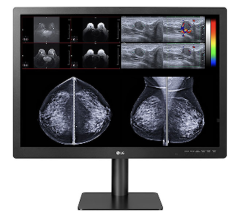
 March 12, 2024
March 12, 2024 
